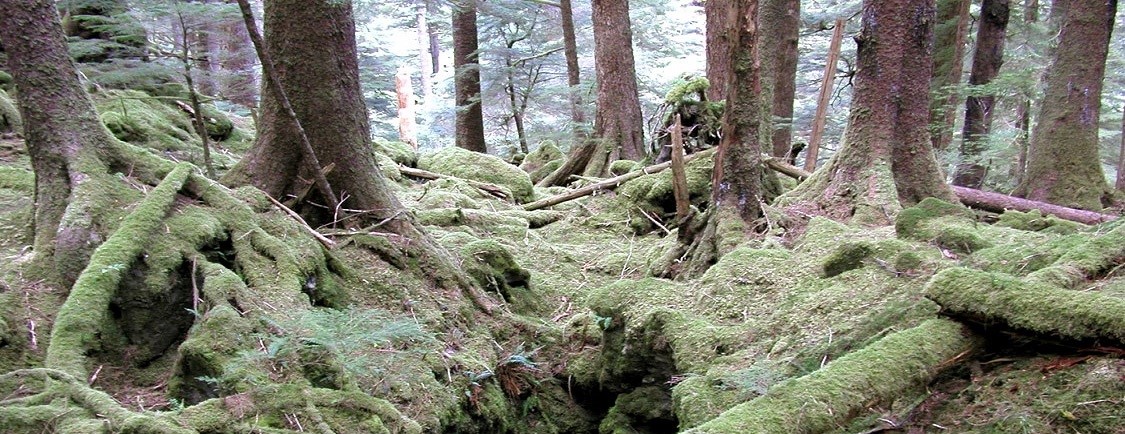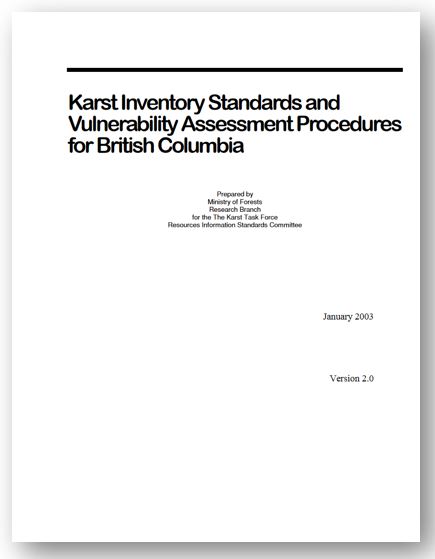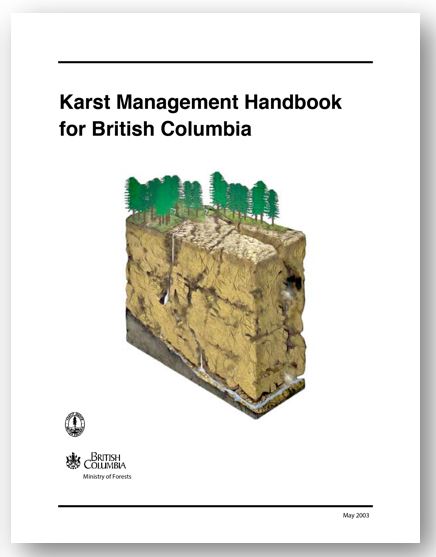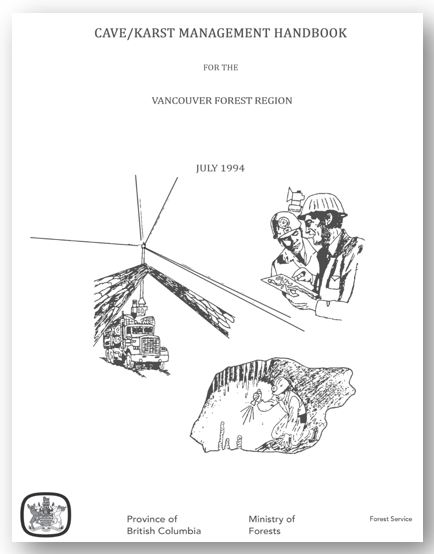Lesson 7: How is Karst Managed in B.C.?

On this page
- Lesson objectives
- Provincial statutory framework for karst management
- Non-statutory karst management policy
- The Karst Management Handbook
- The Cave/Karst Management Handbook for the Vancouver Forest Region
- Karst monitoring and oversight
- Karst and other land use activities in B.C.
- Karst in parks and other legislated protected areas
- Test your knowledge
Lesson objectives
Forestry is the most widespread land-use activity in karst areas in all geographic regions of B.C. For this reason, the province’s karst management framework evolved around the forestry sector.
The great majority of karst resources in B.C. are on Crown land, which comprises 95% of the province’s land base. The Ministry of Forests is the provincial ministry currently most involved in karst management issues across B.C. In some locations of the province, the ministry has designated certain elements of karst as "resource features" to be protected.
The following sections describe some of the main statutory and non-statutory mechanisms for managing karst in B.C., along with provisions for monitoring, oversight, and enforcement. Managing karst in relation to other land-uses such as mining, quarrying, and oil and gas activities, is also discussed.
By the end of this lesson, you should be able to:
- Name the six natural resource districts in B.C. with karst GAR Orders
- Identify the only natural resource district with specific legal objectives for managing karst
- Name the two main provincial karst management guidance documents
- Identify the government program responsible for monitoring karst management in the province
- Identify some of the other provincial agencies responsible for managing land-use activities other than forestry on karst landscapes
Provincial statutory framework for karst management
Government Actions Regulation (GAR) Orders
Six natural resource districts in B.C. use Government Actions Regulation (GAR) Orders to designate various elements of karst as resource features. Resource features must be protected during forestry activities. The six current karst GAR Orders are:
- Order to Identify Karst Resource Features for the Queen Charlotte Islands [Haida Gwaii] Forest District (2006)
- Order to Identify Karst Resource Features for the Campbell River Forest District (2007)
- Order to Identify Karst Resource Features for the North Island–Central Coast Forest District (2007)
- Resource Feature Order for the South Island Forest District (2009)
- Order to Identify Karst Resource Features in the Sunshine Coast (2010)
- Order to Identify Karst Resource Features in the Chilliwack Forest Districts (2010)
These GAR Orders set out three categories of karst resource features for protection:
- Karst caves
- Significant surface karst features
- Important features or elements in high or very high vulnerability karst terrain
Practice requirement for karst resource features
Karst resource features identified in the karst GAR orders are subject to the practice requirement in Section 70(1) of the Forest Planning and Practices Regulation:
“An authorized person who carries out a primary forest activity must ensure that the primary forest activity does not damage or render ineffective a resource feature.”
Since the practice requirement is not expressed as a legal objective, forest agreement holders are not required to write results and strategies to meet the practice requirement in their forest stewardship plans.
Note: Section 56 of the Woodlot Licence Planning and Practices Regulation provides that woodlot licence holders can carry out measures for a resource feature specified in their woodlot licence plans. The woodlot licence holder must ensure that their forest practices do not damage or render ineffective the resource feature if no such measures are specified in the plan.
Haida Gwaii Land Use Objectives Order
Haida Gwaii is a geographical region of B.C. that has a legal objective pertaining to Haida Traditional Heritage Features. Karst features associated with cultural significance receive protection through the Haida Gwaii Land Use Objectives Order. According to the 2019 Background and Intent Document to the Order, “Physical features that are associated with high potential habitation sites, utilized on a temporary or permanent basis for shelter or other significant social or ceremonial activity are ones intended to be protected under this objective of the Order.”
Schedule 2 of the Haida Gwaii Land Use Objectives Order lists ‘karst features’ as possible Class 2 Haida Traditional Heritage Features (HTHFs).
If a karst feature in Haida Gwaii is identified as a Class 2 HTHF, the legal objective is to protect the feature with a 100 m (in average width) no-harvest zone measured outward from the edge of the feature. Forest agreement holders in Haida Gwaii must write measurable and verifiable results and strategies to meet the legal objective in their forest stewardship plans.
Non-statutory karst management policy
The two main provincial karst management guidance documents are intended to be used in tandem:

The Karst Inventory Standards and Vulnerability Assessment Procedures for British Columbia (KISVAP) sets out standard methods and procedures for conducting karst inventories and assessments at three different spatial scales. (See Lesson 8.)

The Karst Management Handbook for British Columbia (KMH) outlines best management practices for protecting natural karst systems and processes, while integrating the management of karst resources with the management of forest lands. The KMH was developed collaboratively with input from karst experts, Ministry of Forests representatives, forest licensees, academics, and other specialists.
Karst Management Handbook
The Karst Management Handbook for British Columbia (KMH) is the standard provincial expectation for managing karst resources on Crown land in a forestry setting. Implementing the KMH is part of the due diligence process used to help meet the legal requirement to protect karst resource features (per Section 70(1) of the Forest Planning and Practices Regulation.)
The strategy for managing karst in B.C. is founded on two basic principles:
- Not all karst features or elements need to be found or known to manage the karst system
- Subsurface karst resources are to be managed through appropriate forest practices applied on the surface
This strategy is multi-scale: the aim is to maintain the integrity of whole karst systems, while conserving a) important surface and subsurface karst features or elements, and b) sensitive karst terrain. B.C.’s karst management strategy is based on the total karst catchment area. Non-karst catchment areas that contribute water to downstream karst should be delineated and appropriately managed where needed.
The Karst Management Handbook for British Columbia (KMH) sets out overarching objectives for managing karst in B.C.:
- Maintain the capability of karst landscapes to regenerate healthy and productive forests after harvesting
- Maintain the high level of biodiversity associated with karst ecosystems, including surface and subsurface habitats
- Maintain the natural flows and water quality of karst hydrological systems
- Maintain the natural rates of air exchange between the surface and subsurface
- Manage and protect significant surface karst features (for example, sinkholes, sinking streams, springs, and cave entrances) and subsurface karst resources (for example, caves, underground streams, and subsurface fauna)
- Provide recreational opportunities where appropriate
These six overarching objectives are precautionary and applicable to entire karst systems (that is, at the total karst catchment scale) down to individual surface and subsurface karst system elements. The KMH also sets out objectives for specific categories of karst features and karst terrain. These operational management objectives do not supplant the overarching karst management objectives, as both may be valid for individual features or the entire karst system.
Best management practices
The KMH outlines best management practices (BMPs) for conducting forestry activities on different categories of features or terrain that include the broad karst landscape as well as specific karst features. BMPs are based on the results of karst field assessments and karst inventories as outlined in KISVAP. The BMPs address:
- Road building and associated activities
- Timber harvesting
- Post-harvest operations
The practice guidelines provided in the KMH also address inventory data security and recreational access to sensitive karst sites or features.
The KMH is intended to be implemented with an adaptive management approach. The BMPs should be followed as much as possible to achieve the KMH’s management objectives for karst. Forest managers who utilize alternative practices to achieve the karst management objectives are responsible for documenting suitable and scientifically sound rationales and accurately recording operational outcomes. Knowledge gained from sound management outcomes using practices that deviate from the BMPs may be used to adjust or fine-tune karst management in B.C. in a continuous improvement cycle. To learn more about the KMH and its BMPs, click on the link below to view the Karst Management Handbook online training course:
Cave/Karst Management Handbook for the Vancouver Forest Region
The Cave/Karst Management Handbook for the Vancouver Forest Region provides guidance for completing the specialized tasks of cave inventories and cave mapping and is referenced in both the KMH and KISVAP.

Karst monitoring and oversight
Forest and Range Evaluation Program
B.C.’s Forest and Range Evaluation Program (FREP) is one of the foundational elements of the results-based forest management framework under the Forest and Range Practices Act (FRPA). FREP is responsible for developing peer-reviewed effectiveness evaluations and science-based monitoring protocols. The FREP mission is to:
- Assess the impacts of forest and range activities on the 11 FRPA resource values to determine if on-the-ground results are achieving government’s desired outcomes for these values
- Monitor and report on the condition of resource values, including trends and causal factors
- Identify opportunities for continued improvement of practices, policies and legislation, and support their implementation
The FREP priority evaluation question for karst is:
“Are current forest practices protecting and maintaining the structure, function and ecological integrity of surface karst features?”
The FREP approach to routine-level monitoring of karst resources is based on a comprehensive set of indicators and methods developed and field tested since 2003.
A comprehensive protocol for monitoring karst is under development.
Forest Practices Board of B.C.
The Forest Practices Board conducts audits and investigations and issues public reports on how well industry and government are meeting the intent of British Columbia’s forest practices legislation. While it does not lay penalties, its recommendations have led directly to improved forest practices such as stronger government decision-making processes and better communication among forestry professionals to manage risks to the environment. The Board can independently audit the effectiveness of forest practices in the management of FRPA resource values, including karst resources identified as resource features. It can also evaluate the adequacy of legislation in relation to karst.
Compliance and enforcement
In B.C., Natural Resource Officers have the mandate to ensure compliance with government regulations that have been established to protect the environment, prevent revenue loss, protect economic or social interests, or improve health and safety. Natural Resource Officers are authorized to enforce a broad range of environmental and natural resource statutes. The Compliance and Enforcement Branch of the Ministry of Forests is mainly responsible for enforcement of the forestry statutes such as the Forest and Range Practices Act and its regulations.
Forest certification
Many of the major forest agreement holders in B.C. have achieved certification under one or more systems. The four main certification systems in B.C. are:
- Sustainable Forestry Initiative (SFI)
- Canadian Standards Association Forest Certification (CSA)
- Forest Stewardship Council (FSC)
- Environmental Management System (ISO 14001)
Forest certification program requirements can oblige participants to consider karst resources when developing and implementing their forestry management plans.
Karst and other land use activities in B.C.
Mining and quarrying
Karst rocks can sometimes hold, or be located close to, important and valuable minerals emplaced by other geomorphic processes involving other rock types.
Mining activities in B.C. include mineral exploration as well as mine production and reclamation. These activities can take place in or near karst, or in non-karst catchment areas that drain to karst units downstream.
Mining or quarrying of limestone, marble, dolomite, and gypsum is designed to remove some of these common karst-forming rocks. Carbonate bedrock, for example, can be developed for aggregates, and dimension and ornamental stone.
The responsibilities of the Ministry of Energy, Mines and Low Carbon Innovation include regulation of the province’s mining and mineral exploration sectors. The consideration of karst can occur when approving mining activities through the issuance of permits under the Mines Act. Site-specific requirements for karst management can be established as permit conditions.
The B.C. Environmental Assessment Office is responsible for reviewing karst management strategies for proposed major mines in B.C. (See below, Other land-use activities and karst in B.C.)
The Health, Safety and Reclamation Code for Mines in British Columbia applies to all mine activities in the province. The Code provides the detailed regulations and standards for these activities, including provisions for minimizing environmental disturbance.
Regional advisory committees established by the Code can review referred applications for mine approvals and reclamation permits. Karst resource issues may be considered as part of this review process.
Oil and gas activities
Oil and gas activities, including wells, facilities, pipelines, petroleum refineries, and oil and gas roads could have the potential to involve karst in B.C.
The B.C. Oil and Gas Commission (the Commission) is the single window regulatory agency with responsibilities for regulating oil and gas activities in British Columbia, including exploration, development, pipeline transportation, and reclamation. The Commission explicitly recognizes karst as a valuable and non-renewable resource that can be highly sensitive to disturbance.
The Commission uses the Oil and Gas Activities Act as the legal enactment to regulate oil and gas activities. The Environmental Protection and Management Regulation (EPMR) under the Act defines karst as a resource feature. Oil and gas activities must not damage or render ineffective a karst resource feature according to the objective prescribed for resource features in the EPMR. A comprehensive guideline document sets out specific requirements for karst.
Proponents of planned oil and gas activities in B.C. are encouraged to report any karst features to the Commission as early as possible, before submitting a permit application.
The proponents must use a qualified professional to conduct a pre-site assessment to confirm the presence or absence of karst where the area of a proposed activity is identified as having karst potential according to provincial karst potential mapping. (See Reconnaissance-level karst inventories in Lesson 8.)
Pre-site assessment results must be submitted to the Commission in the form of a report which includes:
- Justification for the project placement
- Location(s) of identified karst
- Mitigation measures that will be employed to ensure the retention of karst integrity
The Commission encourages proponents to use the Karst Management Handbook for British Columbia when preparing mitigation measures. The Commission reviews permit applications and the adequacy of the planned karst mitigation measures for regulatory compliance and can impose special conditions and specific procedures linked to karst.
Oil and gas activities are carried out and karst mitigation measures implemented only as approved by the Commission.
Other land use activities and karst in B.C.
Examples of other land-use activities in B.C. that can involve karst include electricity generation, transmission, and distribution infrastructure; alternative energy; and waste and refuse disposal sites.
Major projects proposed in B.C. must undergo an environmental assessment managed by the B.C. Environmental Assessment Office, under the Environmental Assessment Act.
Karst in parks and other legislated protected areas
Several protected areas in B.C. have been established specifically for karst. Other protected areas incidentally capture karst or contain very small areas of karst. Protected areas in B.C. include national parks and national park reserves, provincial parks and ecological reserves, and conservancies.
Test your knowledge
Self-Test (True/False)
Answer either True or False to check your understanding:
- B.C. currently has no karst management guidance documents
- The Ministry of Forests is the only ministry in B.C. with responsibilities for managing karst
Answers
-
False. B.C. has two karst management guidance documents. The current version of the Karst Inventory Standards and Vulnerability Assessment Procedures for British Columbia (KISVAP) was released in 2003. It provides comprehensive standards and guidance for conducting karst inventories at three different map scales (these are described in greater detail in Lesson 8). The Karst Management Handbook for British Columbia (KMH) was published in 2003 and provides recommended best practices for managing karst resources inventoried to KISVAP standards.
-
False. Other ministries with direct responsibilities for managing karst in B.C. include (but are not necessarily limited to) the Ministries of Environment and Climate Change Strategy; Agriculture, Food and Fisheries; Energy, Mines and Low Carbon Innovation; and Transportation and Infrastructure. Indirect responsibilities for managing karst in B.C. include accurate and sustainable marketing of karst areas by the Ministry of Tourism, Arts, Culture and Sport through Destination B.C. publications and karst education by the Ministries of Education and Advanced Education and Skills Training. As noted above, the B.C. Oil and Gas Commission is an example of an agency with oversight responsibilities for karst.
